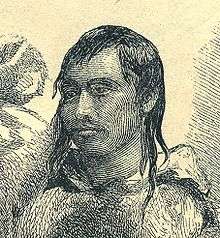Ebierbing

Ebierbing (Inuktitut: Ipiirviq), also known as "Joe," "Eskimo Joe," "Ipirvik", "Eberbing", and "Joseph Ebierbing", c. 1837 - c. 1881, was a remarkable Inuit guide and explorer, who assisted several American Arctic explorers, among them Charles Francis Hall and Frederick Schwatka. Together with his wife Tookoolito, he was one of the best-known and most widely travelled Inuit in the 1860s and 1870s.
Life
The nickname "Joe" was given him by the whalers of Cumberland Sound. In 1852, one of these whalers, Thomas Bowlby, Bolby, or Bowling, took Joe and his partner Tookoolito, known as "Hannah," and another young Inuk with him to the English whaling port of Hull.[1] He exhibited them at several venues, always taking care to let the curious know that Joe and Hannah were man and wife, and had been converted to Christianity. Bowlby made arrangements for them to be received by Queen Victoria, and they apparently made a very favorable impression. Unlike many less scrupulous men, Bowlby returned all three Inuit to the Arctic safe and well.
In 1860, Ebierbing and Tookoolito met Charles Francis Hall, and worked closely with him as he sought to trace Inuit oral traditions about the 16th-century expedition of Martin Frobisher. Tookoolito worked principally as Hall's translator, while Ebierbing served as guide and hunter. Having located the original site of Frobisher's attempted settlement, Hall returned to the United States in 1862; Ebierbing, Tookoolito accompanied him, along with their infant son "Butterfly" (Inuktitut: Tukerliktu). Hall had the Inuit family appear with him when he gave his talk on the Frobisher relics at the American Geographical Society, and realizing the high degree of interest in them, arranged with P. T. Barnum for their exhibition at Barnum's American Museum. Hall arranged for their exhibition shortly afterwards at the Boston Aquarial Gardens, but when no payment was forthcoming for this second exhibit, swore off any more dealings with "Show Establishments." Nevertheless, Ebierbing and Tookoolito, along with little Tukerliktu, appeared with Hall during his east coast lecture tour of 1863; the strain of the tour led to health problems for both "Hannah" and her son, and a few weeks later "Butterfly" was dead.
Together with Tookoolito, he accompanied Hall on his final voyage, the Polaris expedition (1871–1873) in search of the North Pole. He was among the party left behind after Hall's death, when the ship broke loose of the ice and failed to return. During the party's six-month drift on a gradually-shrinking icefloe, Ebierbing and the Greenlandic Inuk Hans Hendrik managed to provide food for the entire party; they were eventually picked up by a sealer in April 1873. During the investigation into Hall's death, both Ebierbing and Tookoolito supported Hall's claim that he had been poisoned, but their evidence was discounted.[2] The couple returned to Groton, Connecticut, although Ebierbing returned to the Arctic periodically to work as a guide, while Tookoolito remained behind, caring for their daughter Panik[3] and working as a seamstress. After Panik, whose health had been poor since her experience on the icefloe, died at the age of nine, Hannah fell into declining health. Joe was with her when she died on December 31, 1876; she was buried in the Starr Burying Ground not far from the Budington family plot.
Ebierbing died in the Arctic sometime in 1881; the details of his death are unknown.
The island Joe Island is named after Joe Ebierbing, the island is located just outside to the left of Petermann Fjord off Kap Morton in Kennedy Channel. Hannah Island, in the mouth of Bessels Fjord next fjord to the south of Petermann Fjord, is named after his wife Hannah (Tookoolito).
See also
References
- ↑ Loomis, Chauncey. "Ebierbing (ca. 1837-ca. 1881)" (pdf). Department of English Arctic Profiles. Dartmouth college Hanover, New Hampshire. Retrieved 2009-10-03.
- ↑ Petrone, Northern Voices, pp. 66–72
- ↑ Panik is an Inuit language word simply meaning daughter. Inuinnaqtun to English page 68.
Bibliography
- Harper, Kenn (1989). "History on a Headstone: A Long-forgotten chapter of Inuit Heroism". Above and Beyond. 1 (2): 53–62.
- Jones, HG. (2002). "Teaching the Explorers: Some Inuit Contributions to Arctic Discoveries". Polar Geography. 26 (1): 4–20. doi:10.1080/789609350.
- Loomis, Chauncey. (1971) Weird and Tragic Shores: The Story of Charles Francis Hall, Explorer NY: Alfred A. Knopf, ISBN 0-394-45131-7
- Petrone, Penny. (1988) Northern Voices: Inuit Writing in English. Toronto: University of Toronto Press, ISBN 0-8020-7717-X